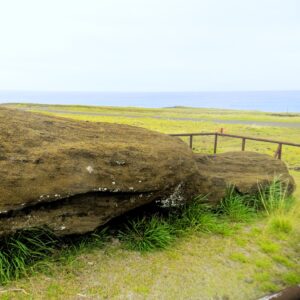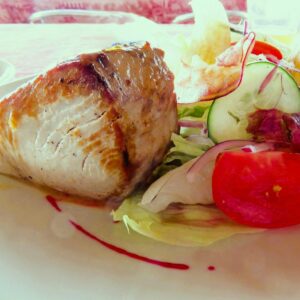
Easter Island, Hawaii, and New Zealand form the corners of the Polynesia Triangle in the southern Pacific Ocean. Rapa Nui is the indigenous name of Easter Island. Chileans call it Isla de Pascua. Its first settlers reached the island around the year 300 in outrigger canoes. From the 10th century to the 16th century, its inhabitants built giant mysterious stone figures known as moai 🗿. The small remote island is also triangular and easily explored with an SUV.
Adventures | Must Sees | Food | Moai Stats

MUST SEES

Rano Raraku
The Rapa Nui carved monoliths on the volcano and transported them across the island. The slopes have moai of all shapes and sizes. When people think of Easter Island, they think of just the heads. The bodies were in pits waiting to be moved.
Ahu Tongariki
Ahu Tongariki is between Poike volcano and Rano Raraku. The ceremonial structure contains 15 megaliths on an ahu (stone pedestal). In 1960, a tsunami scattered the statues. In 1992, a Chilean-Japanese team restored the moai.
Anakena
Anakena is the spot where the founding king of the Rapa Nui people, Hotu Matu’a, first stepped on the island. The statues here are still wearing their red pukao – hats made of red scoria rock. You can swim by the white coral sand beach.
Ahu Akivi
The moai face the farms at the center except for these seven at Ahu Akivi. They face the sea. A legend goes that the king had a vision of Rapa Nui. So, the king sent scouts to find the island. Seven stayed behind and waited here for the king to arrive.
Ahu Tahai
The Tahai Ceremonial Complex consists of three principal ahu. Ko Te Riku is a moai with restored eyes and a pukao. The moai had faces of ruling ancestors. They watched over the villages and protected the clans with their mana (life force).
Pu O Hiro
Hiro’s Trumpet allegedly produced sounds that could attract fish to the coast. It was also a war trophy, which clans paraded from one end of the island to the other.
Papa Vaka
The petroglyphs at Papa Vaka demonstrate how important the ocean was to Rapa Nui culture. Most of the art depicts canoes, hooks, sharks, and the highly prized tuna.
Te Pito Kura
At Te Pito Kura, Paro was the largest moai to ever stand on an ahu. It is almost 32.8 feet tall and 82 tons. A widow ordered this moai for her late husband and it was the last to be knocked down.
Te Ara O Te Moai
Te Ara O Te Moai was the main road for transporting the moai from the Rano Raraku quarry. There are four roads littered with moai that did not make it to their final destinations.
Vaihu
Rapa Nui society collapsed in the 1500s after deforestation and ecological crisis. As the ancestor cult ended, warfare damaged all the statues. When the eight moai toppled over, the red pukao (hats) rolled great distances with some even falling into the sea.
Akahanga
The sons of Rapa Nui’s first king, Hotu Matu’a, buried the king’s remains at Ahu Akahanga. Warring clans knocked down the 13 statues at Ahu Akahanga both face up and face down. Near the site, there are stone ovens and foundations of boat houses.
Orongo
Around the 16th century, Rapa Nui society abandoned the megalithic ideology of the moai and turned to a birdman cult. The birdman ceremony was performed at Orongo’s round-walled stone buildings overlooking the Rano Kau caldera.
Hanga Roa
Hanga Roa is the main town in Rapa Nui. It is the only place you can find gas, food, and lodging. The rest of the island is primarily farms.
FOOD

Empanada Oru
You can get empanadas that are as big as two fists. The empanada oru has soft juicy tuna (tender even when not seared or raw), shrimp, tomatoes, and onions.
Tuna
On the island, they know how to grill fresh tuna through low and slow heat. The tuna is as soft and juicy as a seared filet. This is a simple preparation that highlights the natural flavors of the fish. You should also try the tuna ceviche.
Caldillo
The little cauldron contains a wealth of oceanic treasures. The soup has mussels, white fish, and shrimp. The potatoes, onions, and carrots are topped with a butter tarragon sauce.
MOAI STATS
887Total moai on Rapa Nui 288Total moai successfully transported to ahus 397Total moai still in Rano Raraku quarry 92Total moai left in transit |
Keep Exploring!
Africa | Antarctica | Asia | Australia | Europe | Middle East | North America | South America